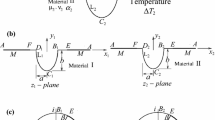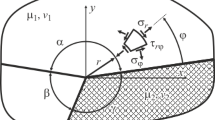Abstract
A closed-form solution is derived for the bonded bimaterial planes at two interfaces subjected to different temperatures. The bonded planes with two interfaces are symmetric with respect to the interface, which is straight. A rational mapping function and complex stress functions are used for the analysis. The problem is reduced to a Riemann–Hilbert problem. The solution includes an integral term. This integral cannot be carried out. However, the first derivative of complex stress functions which does not include integral terms with regard to the variables of the mapping plane is achieved. Therefore, there is no need for numerical integration to calculate stress components and to determine unknown coefficients in a complex stress function. This is very beneficial. It is more difficult to derive the solution to the two-interface problem compared to the general solution. As a demonstration of geometry, semi-strips bonded in two places at the ends of strips are considered. Unbonded parts are a model of debonding. The solution for different geometrical shapes can be obtained by changing the mapping function. Some stress distributions are shown for different lengths of the interface. The stress intensity of debonding (SID) (corresponding to the root of strain energy release rate) is investigated for the debonding extension. SID is the same as the root of strain energy release rate for the evaluation of the strength at the debonding tip.







Similar content being viewed by others
References
Hasebe, N., Kato, S., Ueda, A., Nakamura, T.: Stress analysis of dissimilar strip with debondings. Trans. Jpn. Soc. Mech. Eng. 66(577A), 1959–1966 (1994). (In Japanese)
Hasebe, N., Kato, S., Nakamura, T.: Bimaterial problem of strip with debondings under tension and bending. Am. Soc. Test. Mater. STP 1220(25), 206–221 (1995)
Hasebe, N., Kato, S., Ueda, A., Nakamura, T.: Stress analysis of bimaterial strip with debondings under tension. JSME Int. J. 39(2A), 157–165 (1996)
Hasebe, N., Kato, S.: Solution of problem of two dissimilar materials bonded at one interface subjected to temperature. Arch. Appl. Mech. 84(6), 913–931 (2014)
Djokovic, J.M., Nikolic, R.R., Tadic, S.S.: Influence of temperature on behavior of the interfacial crack between the two layers. Therm. Sci. 14, 259–268 (2010)
Quyang, Z., Ji, G., Li, G.: On approximately realizing and characterizing pure Mode-I interface fracture between bonded dissimilar materials. ASME J. Appl. Mech. 78(3), 031020-1–031020-11 (2011)
Lan, X., Noda, A., Zhang, Y., Michinaka, K.: Single and double edge interface crack solutions of material combination. Acta Mech. Solida Sin. 25(4), 404–416 (2012)
Li, Y., Viola, E.: Size effect investigation of a central interface crack between two bonded dissimilar materials. Compos. Struct. 105(12), 90–107 (2013)
Afendi, M., Majid, M.S.A., Daud, R., Rahman, A., Teramoto, T.: Strength prediction and reliability of brittle epoxy adhesively bonded dissimilar joint. Int. J. Adhes. Adhes. 45, 21–31 (2013)
Ma, L., He, R., Zhang, J., Shaw, B.: A simple model for the study of the tolerance of interfacial crack under thermal load. Acta Mech. 224(7), 1571–1577 (2013)
Yousefsani, S.A., Tahani, M.: An analytical investigation on thermo-mechanical stress analysis of adhesively bonded joints undergoing heat conduction. Arch. Appl. Mech. 84, 67–79 (2014)
Banks-Sills, L.: 50th anniversary article: review on interface fracture and delamination of composites. Strain 50(2), 98–110 (2014)
Hasebe, N., Kato, S.: Solution of bonded bimaterial problem of two interfaces subjected to concentrated forces and couples. ZAMM J. Appl. Math. Mech. (2015) (on line)
Dundurs, J.: Effect of elastic constants on stress in composite under plane deformation. J. Compos. Mater. 1, 310–322 (1967)
Muskhelishvili, N.I.: Some Basic Problems of Mathematical Theory of Elasticity, 4th edn. Noordfoff, Netherlands (1963)
Salganic, R.L.: The brittle fracture of cemented body. PMM J. Appl. Math. Mech. 27(5), 1468–1478 (1963)
Hasebe, N., Okumura, M., Nakamura, T.: A crack and debonding at the edge of bonded bimaterial half planes under couples. Jpn. Soc. Mater. Sci. Jpn. 39(445), 1405–1410 (1990). (In Japanese)
Hasebe, N., Tsutsui, S., Nakamura, T.: Debondings at a semielliptical rigid inclusion on the rim of a half plane. ASME J. Appl. Mech. 55, 574–579 (1988)
Hasebe, N., Tsutsui, S., Nakamura, T.: A mixed boundary value problem for debonding of a semi-elliptic rigid inclusion. Arch. Appl. Mech. 62, 306–315 (1992)
Author information
Authors and Affiliations
Corresponding author
Appendices
Appendix 1: Derivation of \(\overline{F_{11} (1/\bar{{t}}_1)}\)
Taking the conjugate of function \(F_{11} (t_1 )\) for \(j=1\) in Eq. (38c), the following equation is obtained:
Using the relations \(\bar{{\sigma }}=1/\sigma , \bar{{\alpha }}_2 =1/\alpha _2\), and \(\bar{{\beta }}_1 =1/\beta _1 \) on the unit circle, the equation above is
where the following relation was used:
\(I_{21} (0)\) is derived as follows: When the variable \(\sigma \) is transformed on the real variable t by
the following equation is obtained:
where
Values of the elliptical integral type \(I_{21} (0)\) must be calculated by a numerical integration regarding real variable t (see Appendix 4).
Appendix 2: Derivation of function \(P_1 (t_1 )\)
Substituting Eqs. (42) and (44) into Eq. (7), the following equation is derived:
The equation above has poles at \(t_1 ={\zeta }_k^{'}(k=1,2,3,\ldots ,N)\). When \(\overline{\chi _1 (1/\overline{t_1} )} \overline{P_1 (1/\overline{t_1} )} \) is expanded to Laurent series at \(t_1 ={\zeta }_k^{'}, \overline{\chi _1 (1/\overline{t_1 } )} \overline{P_1 (1/\overline{t_1} )} \) is expressed as:
The unknown constant \(\bar{{q}}_k \) is determined so that \(\psi _1 (t_1 )\) is regular at \(t_1 ={\zeta }_k^{'} \) as follows:
\(\therefore \)
Appendix 3: Determination of \(a_{1l} ,\hbox {b}_{1l},\xi _{1l} ,\eta _{1l} \)
Using Eqs. (30) and (45), function \(\Theta _1 (t_1 )\) expressed by Eq. (16) is expressed as follows:
where the following relations were used:
It was derived that the following term in Eq. (75) was zero, using Eq. (48):
where \(H_1 (t_1)\) and \(\overline{H_2 (1/\bar{{t}}_1 )} \) are obtained by Eq. (40). Also, the constant term
is included in the arbitrariness of the stress function. The function \(\Theta _1 (t_1 )\) expressed by Eq. (75) is the same as the function \(\Theta _1 (t_1 )\) expressed by Eq. (28) and Eq. (18), i.e.,
Because Eqs. (75) and (79) are the same equation, these equations have the same poles inside and outside regions, \(S_1^+ \) and \(S_1^- \), respectively. From this condition, the following relations are obtained:
And coefficients of terms including \(\chi _1 (t_1 )\) and not including \(\chi _1 (t_1 )\) must equal at the same poles inside and outside regions, \(S_1^+ \) and \(S_1^- \), respectively. Comparing the coefficients, the following relations are obtained:
For material II, the same procedure is done, and the coefficients are expressed by exchanging suffixes \(j=1\) and 2. Then, Eqs. (49) and (50) are obtained.
Appendix 4: First derivative of functions \(F_{j1} (t_j )\)
The first derivative of function \(F_{j1} (t_j )\) which is defined in Eq. (38c) is obtained as follows [19]:
where
\(\chi _j (t_j )\) is given by Eq. (22).
Variables \(t_{\alpha _1} , t_{\beta _1} , t_{\alpha _2} \), and \(t_{\beta _2}\) are given in Eq. (70d). \(I_{j1} (n)(n=0,1,2)\) is defined by the following equations:
The above integrals of elliptical type \(I_{j1} (n)(n=0,1,2)\) must be obtained by a numerical integration with respect to the real variable t (see Eq. 68b).
Rights and permissions
About this article
Cite this article
Hasebe, N., Kato, S. Solution of a bonded bimaterial problem of two interfaces subjected to different temperatures. Arch Appl Mech 86, 445–464 (2016). https://doi.org/10.1007/s00419-015-1040-5
Received:
Accepted:
Published:
Issue Date:
DOI: https://doi.org/10.1007/s00419-015-1040-5




